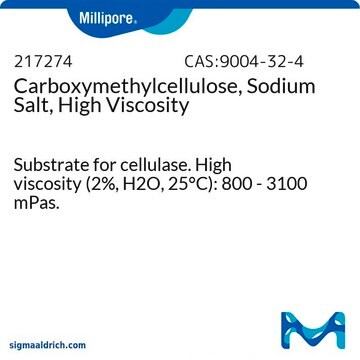추천 제품
생물학적 소스
wood (pulp)
형태
powder
색상
light yellow
유용한 pH 범위
(20 °C, 10 g/L, 68 °F neutral)
점도
1500-3000 cP, 1 % in H2O(25 °C)(lit.)
mp
> 300.05 °C ((> 572.09 °F ))
solubility
H2O: 10 mg/mL
양이온 미량물
Na: 6.5-9.5%
저장 온도
room temp
InChI
1S/C6H12O6.C2H4O2.Na/c7-1-3(9)5(11)6(12)4(10)2-8;1-2(3)4;/h1,3-6,8-12H,2H2;1H3,(H,3,4);
InChI key
DPXJVFZANSGRMM-UHFFFAOYSA-N
유사한 제품을 찾으십니까? 방문 제품 비교 안내
일반 설명
This product is a high viscosity carboxymethylcellulose (CMC); the viscosity of a 1% solution in water at 25 oC is 1500-3000 centipoise (cps). The viscosity is both concentration and temperature dependent. As the temperaure increases, the viscosity decreases. As the concentration increases, the viscosity increases.Low, medium and high viscosity CMCs are all used as suspending agents. Low viscosity CMC is usually used in ""thin"" aqueous solutions. Medium viscosity CMC is used to make solutions that look like a syrup. High viscosity CMC is used to make a mixture, which resembles a cream or lotion.
애플리케이션
Soluble carboxymethylcelluloses (CM-cellulose; CMC) available in varying viscosities are used as viscosity modifiers (thickeners) to stabilize emulsions and as a chemical dispersants of oils and other carbon structures such as nanotubes. CMCs are used in the development of biostructures such as biofilms, emulsions and nanoparticles for drug delivery. Carboxymethylcellulose, high viscosity, may be used to make solutions the consistency of creams or lotions.
제조 메모
The product is soluble in water (10 mg/ml). The key to dissolving carboxymethylcellulose is to add the solid carefully to the water so that it is well dispersed (well-wetted). Adding the solid in portions may be necessary. Adding water to the dry solid produces a "clump" of solid that is very difficult to dissolve; the solid must be added to the water. Stir gently or shake intermittently; do not stir constantly with a magnetic stirring bar. High heat is not needed and may actually slow down the solubilization process. A mixing device, such as an impeller-type agitator which produces a vortex, would allow the powder to be drawn into the liquid, but it may produce some shearing. Note that this high viscosity CMC is usually used at concentrations of less than 20 mg/ml, but it is soluble in water at up to 50 mg/ml; heat is required to prepare a 50 mg/ml solution.
기타 정보
To gain a comprehensive understanding of our extensive range of Polysaccharides for your research, we encourage you to visit our Carbohydrates Category page.
Storage Class Code
11 - Combustible Solids
WGK
WGK 1
Flash Point (°F)
Not applicable
Flash Point (°C)
Not applicable
개인 보호 장비
Eyeshields, Gloves, type N95 (US)
시험 성적서(COA)
제품의 로트/배치 번호를 입력하여 시험 성적서(COA)을 검색하십시오. 로트 및 배치 번호는 제품 라벨에 있는 ‘로트’ 또는 ‘배치’라는 용어 뒤에서 찾을 수 있습니다.
이미 열람한 고객
Shannah K Witchey et al.
Neurotoxicology, 74, 139-148 (2019-06-30)
Bisphenol A (BPA) is a well-characterized endocrine disrupting chemical (EDC) used in plastics, epoxy resins and other products. Neurodevelopmental effects of BPA exposure are a major concern with multiple rodent and human studies showing that early life BPA exposure may
Sarah A Johnson et al.
Hormones and behavior, 80, 139-148 (2015-10-06)
Bisphenol A (BPA) is a ubiquitous industrial chemical used in the production of a wide variety of items. Previous studies suggest BPA exposure may result in neuro-disruptive effects; however, data are inconsistent across animal and human studies. As part of
Shafiqul I Chowdhury et al.
Vaccines, 9(1) (2021-01-17)
The bovine respiratory disease complex (BRDC) remains a major problem for both beef and dairy cattle industries worldwide. BRDC frequently involves an initial viral respiratory infection resulting in immunosuppression, which creates a favorable condition for fatal secondary bacterial infection. Current
Wai-Hong Wu et al.
Virology journal, 12, 140-140 (2015-09-13)
Infection by any one of 15 high risk human papillomavirus (hrHPV) types causes most invasive cervical cancers. Their oncogenic genome is encapsidated by L1 (major) and L2 (minor) coat proteins. Current HPV prophylactic vaccines are composed of L1 virus-like particles
Sheryl E Arambula et al.
Neurotoxicology, 65, 207-220 (2017-11-04)
Bisphenol A (BPA) is a widely recognized endocrine disruptor prevalent in many household items. Because experimental and epidemiological data suggest links between prenatal BPA exposure and altered affective behaviors in children, even at levels below the current US FDA No
자사의 과학자팀은 생명 과학, 재료 과학, 화학 합성, 크로마토그래피, 분석 및 기타 많은 영역을 포함한 모든 과학 분야에 경험이 있습니다..
고객지원팀으로 연락바랍니다.

